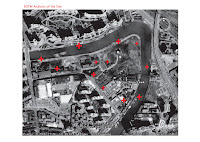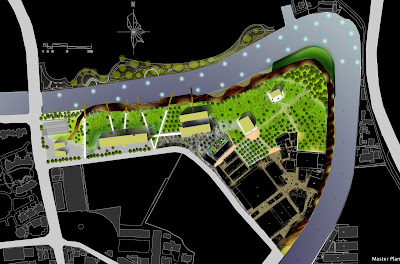Ian Wale - England
Wendy Zhang - Malaysia
Kenya Endo - Japan
Deema Gh. -Kuwait
Fei Wenjun - China
Lynn Wang - China
Wendy Zhang - Malaysia
Kenya Endo - Japan
Deema Gh. -Kuwait
Fei Wenjun - China
Lynn Wang - China
- The following article is my own perspective towards our design and experience, there is a lot that I couldn't trace by words in where I placed my photos:
Symbiosis: Cityscape & Landscape

History and location had proven Shanghai to be the open door to China and an expected metropolis, thus it is the perfect place to experiment the meet from variety of cultures in order to simulate the city context. Tongji University had chosen the perfect site for the summer school workshop. A place infected by the forces of change. The site used to be the industrial district in Shanghai, but the urban development and expanse occurred during the last decades over flew the area and took away its functioning privilege. The government moved the factories to the rural and reserved some of the existing buildings for restoration and reuse.


This action configured a new quality to the site. On an urban view it has a confinement-relief value of space. And on a human perspective a new motion was in the density inter-spaces. M50 project used the remaining built part of the area (confinement part) to be an art district; where the old low rise buildings become the muses for artists and designers’ invention. The other side of the area –also to be the riverside- is rather a very relieved part where nature overgrows and very few buildings remained, yet standing out. It is a riddle of memory left by banished urban fabric.

In the workshop we were split into groups of six. In my group there were two persons from China, one from Malaysia, one from England, also one from Japan and myself from Kuwait. So we all came from different backgrounds different languages and strategies. It is a bit hard to deal with such variety but we accepted the challenge with our architectural language.


Initially we applied an analyzing method in which we explored –through our captured photographic frames- the possibilities of the space that is affected by existing phenomenon. The method revealed a symbiotic formation between nature and man made as well as old and new. Afterwards we were split to enhance the qualities of each critical point that joins the whole; those are the river band, the density relief, the paths and the street circulation. This is how we created the program, because associating these points with the term “urban memory” -and thus industrial heritage- demands the term “production”, and the latter term is the answer –still hypothetical- for the mentioned critical points.
Our strategy was to set upon the future need for the artists to benefit from their potentials to strengthen their financial status to cope with the expected rising rental cost of the M50 district. So we decided to turn the building that used to be a flour factory into an active art school for children, then this place would be an experimental zone for both artists (coming out from their galleries and studios) and the new generations (coming out from their residential areas all around).
The term “production” is correlated to the term “display”. In respect to this fact we chose to transform a building that used to be a hotel into a building that receive and display, especially that the hotel has a strategic location being the first architectural element along the entrance axis from the street. This place will be the cultural part of the landscape accommodating indoor and outdoor events, introducing you to either the river band or the children’s area.
Another axis to the site is from the M50 district; it is there where nature and man made reflection is being sensed by the rational (grid-like) placement of trees that gradually spread in a more organic way. It is the inspiration zone where art and knowledge emerge through the beauty and intellect of nature.

The levee is transforming along the river due to change in activities from viewing to fishing and from wandering to accessing. The river band is treated in the crescent-like area so that the water can be filtrated with time by rocks and plants to attract birds and increase natural inhabitants.
As mentioned, “Urban Memory” is a term dependent on vision and time, what we present in our design is a frame of what exist towards what existed in a great respect to the phenomenal claim.
The Landscape here is an expression of the amalgamation of natural and domestic topography. By using the low-rise natural space as a gravity force that attracts the rising surrounding. And as change being hyperactive in Shanghai it is left to the occupants around the area, the artists and the children to generate changes either predicted or not. And it will be consequent of our adjustments, which reacts to the M50 recently running program.
As mentioned, “Urban Memory” is a term dependent on vision and time, what we present in our design is a frame of what exist towards what existed in a great respect to the phenomenal claim.
The Landscape here is an expression of the amalgamation of natural and domestic topography. By using the low-rise natural space as a gravity force that attracts the rising surrounding. And as change being hyperactive in Shanghai it is left to the occupants around the area, the artists and the children to generate changes either predicted or not. And it will be consequent of our adjustments, which reacts to the M50 recently running program.

Summery:
A workshop held in Tongji University had brought human skills from multiple countries to design the given space under the “Urban Memory & Landscape” conception. From this subjective meaning we in Group Six decided to understand and unite each existing phenomenon for it to transform and grow in rather a beneficial manner, to Eco-system as well as economy.
As The modern city of Shanghai, is being in the hands of her children. And as the history of the district in study, is used to be the source of industrial production. We chose to vibrate the heart of the landscape with art classes for them, which act as a metaphor for the term “production”. These classes with M50 district will merge together through the natural surrounding, providing rental spaces for artists to display their work and therefore nature will be veiling and unveiling art as we walk from a place to another by the law of perspective.
All the activities will be woven by the treatment of the levee along the river, where we intended to attract new natural inhabitants to the area and apply some methods to filtrate the river. We want the area on the river band to be more bio-active in order to heal itself in the long term.
My personal experience was more into the long-term strategy of the landscape and the possibilities of its growth mainly concerned about the growth of the M50 district to the natural zone. This workshop had taught me a lot about the Chinese heritage, and Shanghai told me beautiful stories by the colors of her nights and on the faces of her people. I believe that the image of Shanghai will make its perfect sense if it reflects the strong character of Chinese people. If we trace the daily life of Chinese people we can predict innovative urban strategies toward this city.
A workshop held in Tongji University had brought human skills from multiple countries to design the given space under the “Urban Memory & Landscape” conception. From this subjective meaning we in Group Six decided to understand and unite each existing phenomenon for it to transform and grow in rather a beneficial manner, to Eco-system as well as economy.
As The modern city of Shanghai, is being in the hands of her children. And as the history of the district in study, is used to be the source of industrial production. We chose to vibrate the heart of the landscape with art classes for them, which act as a metaphor for the term “production”. These classes with M50 district will merge together through the natural surrounding, providing rental spaces for artists to display their work and therefore nature will be veiling and unveiling art as we walk from a place to another by the law of perspective.
All the activities will be woven by the treatment of the levee along the river, where we intended to attract new natural inhabitants to the area and apply some methods to filtrate the river. We want the area on the river band to be more bio-active in order to heal itself in the long term.
My personal experience was more into the long-term strategy of the landscape and the possibilities of its growth mainly concerned about the growth of the M50 district to the natural zone. This workshop had taught me a lot about the Chinese heritage, and Shanghai told me beautiful stories by the colors of her nights and on the faces of her people. I believe that the image of Shanghai will make its perfect sense if it reflects the strong character of Chinese people. If we trace the daily life of Chinese people we can predict innovative urban strategies toward this city.